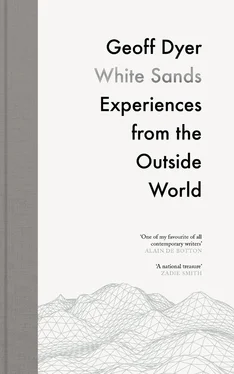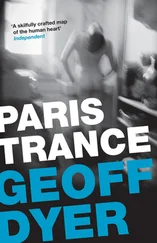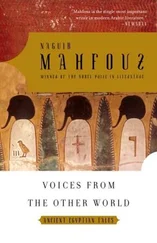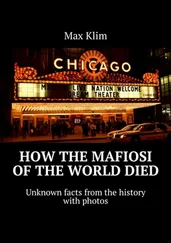Our final bit of measuring was to confirm what we referred to thereafter as the Ethan-Cristina paradox.
‘The poles are all different lengths,’ said Cristina (who is tall).
‘Because they’re all the same height,’ said Ethan (who is short).
He was right. They averaged about twenty feet, but the shortest was only fifteen feet, the tallest twenty-six feet nine inches. The variations in length took account of the uneven surface of the land, so that from tip to tip of every pole was this level plane of invisible flatness. Given the precision of all the distances involved, we wondered if this place was a tribute to the god of measuring ? Did even the richly stocked pantheon of Hinduism include such a deity?
So the question remained. Apart from suggesting that precise measuring could correct the wonkiness of the world, what was this place meant to do? What was its purpose? Where were we?
The last question is easily answered: we were — as you may have guessed by now — near Quemado, at The Lightning Field, created by Walter De Maria and completed in 1977. The answer prompts another question — why the subterfuge of inconceivable ignorance? — which, in turn, takes the form of further questions.
A copy of De Maria’s obsessively minute inventory and visionary manifesto, ‘The Lightning Field: Some Facts, Notes, Data, Information, Statistics, and Statements,’ is left in the hut, but even before arriving — and even if their knowledge of the stats is a little hazy — most visitors who come to The Lightning Field know roughly what they are in for. But what if we came here and had to try to work it out for ourselves, with no art-historical back-up? Asked about the consequences of the French Revolution, Chou En-lai replied, ‘It’s too soon to tell.’ That’s the response that comes to mind when pondering the significance of the great Land Art projects of the late 1960s and 1970s. With their megalomaniacal schemes and gargantuan undertakings — some, like James Turrell’s Roden Crater in Arizona, or Michael Heizer’s City in Nevada, still uncompleted after more than forty years — these artists were thinking big, not just in size and space but in time . If they succeed, the best of their undertakings have more in common with sacred or prehistoric sites than with the rival claims and fads of contemporary art. The art stuff provides an immediate context, but it is more revealing to take a different and larger perspective.
One of the most obvious things is as easily overlooked as the poles in the middle of the afternoon: everything about The Lightning Field suggests that it will be here for many years to come. So what if we visited the site years hence and had to try to figure out for ourselves what was happening here, what forces were at work, with no art-historical context (minimalism, conceptualism, taking work out of the gallery into the expanded field, etc.)? Enlarging the time scale still further, what if The Lightning Field survived after there were people left to see it? How long would it take an alien intelligence — or, to put it another way, how intelligent would an alien have to be — to work out what was going on here? (Could that be the simple mark of genius: when something is easier to conceive and create than it is to work out how it was done?)
One thing present-day visitors tend not to know about The Lightning Field —or are reluctant to accept — is that it is naïve, even a little vulgar, to expect lightning . We came in early May, on only the second day that The Lightning Field had been open for the season, but even during the peak period of storm activity, July to September, lightning strikes are exceptional. De Maria spent years searching for an appropriate spot, somewhere with a high incidence of storms. He estimated that there are ‘approximately sixty days per year when thunder and lightning activity can be witnessed from The Lightning Field.’ I don’t know if any record has been kept of the number of lightning storms that have converged on the field itself, but you would count yourself very lucky if you happened to witness what must, surely, be one of the greatest shows on earth. De Maria has rightly insisted that the light is every bit as important as the light ning (‘the invisible is real’), but calling it The Lightning Field was a sensational bit of marketing. Does any artwork have a more electrifying name?
The fact that lightning so rarely appears does not detract from the intended purpose and effect of a place that is helpfully understood in Heideggerian terms. Seeking to explain the relationship of man-made objects to the surrounding landscape in ‘Building Dwelling Thinking’ Heidegger writes that a bridge ‘does not just connect banks that are already there. The banks emerge as banks only as the bridge crosses the stream. The bridge expressly causes them to lie across from each other.’ From this it follows that the bridge effectively brings or leads the stream to flow under it and between these banks. ‘The bridge gathers the earth as landscape around the stream. Thus it guides and attends the stream through the meadows.’
The tail wags the dog in similar and, for our purposes, more explicit fashion in ‘The Origin of the Work of Art,’ where Heidegger insists that a temple standing on rocky ground draws up out of the rock its ‘bulky yet spontaneous support.’ Furthermore, the building does not just hold its ground against the storm raging around it but ‘first makes the storm itself manifest in its violence.’ And not only that: ‘The lustre and gleam of the stone, though itself apparently glowing only by the grace of the sun, first brings to radiance the light of the day, the breadth of the sky, the darkness of the night. The temple’s firm towering makes visible the invisible space of air. ’ [My italics.]
Notwithstanding this extraordinary sense of cause-generating effect, over the years voices have occasionally dissented from the consensually reverent view of De Maria’s achievement. The Dia Art Foundation (which administers the site) controls access to The Lightning Field and which photographs of it can appear in print. You can’t just drop in, take a quick look and drive off. You have to stay the night, and since the cabin accommodates only six people, you have to book well in advance. Taking aim at these ‘authoritarian’ measures in a briefly notorious essay, a critic named John Beardsley claimed that the build-up helped ‘insure that one will fully expect to see God at the Lightning Field. Needless to say, He doesn’t appear. No artwork could live up to this hype.’
Except it could and it does. Even without the bonus of lightning, the experience of The Lightning Field transcends its reputation. Of course god does not appear. There’s a lot of space but, even as a figure of speech, there’s no room for god. The Lightning Field offers an intensity of experience that for a long time could be articulated only — or most conveniently — within the language of religion. Faced with huge experiences, we have a tendency to fall to our knees, because it’s a well-rehearsed expression of awe. Nothing about The Lightning Field prompts one to genuflect in this way. Considering some archaeological sites, Lewis Mumford concluded, quite reasonably, ‘It is only for their gods that men exert themselves so extravagantly.’ The Lightning Field represents an absolute refutation or, more precisely, the expiration of that claim — unless art has now become a god. Rigorously atheistic, geometrically neutral, it takes the faith and vaulting promise of modernism into the wilderness. Part of the experience of coming here is the attempt to understand and articulate one’s responses to the experience.
Читать дальше












